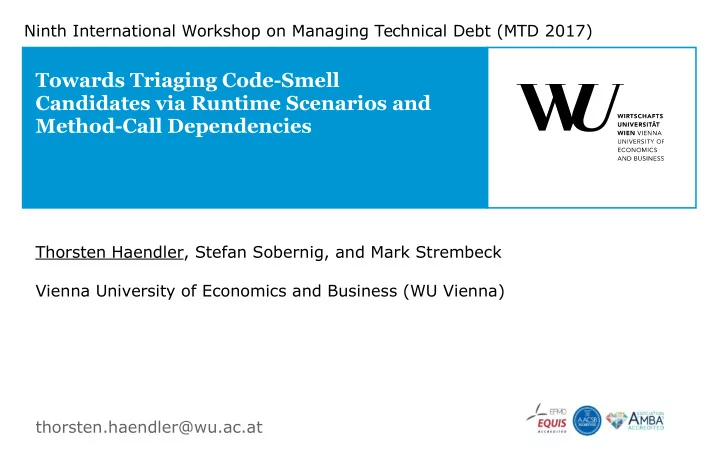

Ninth International Workshop on Managing Technical Debt (MTD 2017) Towards Triaging Code-Smell Candidates via Runtime Scenarios and Method-Call Dependencies Thorsten Haendler, Stefan Sobernig, and Mark Strembeck Vienna University of Economics and Business (WU Vienna) thorsten.haendler@wu.ac.at
Assessment of smell candidates Smell-detection tools produce false positives and/or miss smell candidates (due to applied detection technique: mostly static program analysis) In general, smells also might result from a deliberate design decision (Arcelli Fontana et al., 2016; intentional smell ) Smell Triage A) symptom-based identification and assessment B) re-assessment of true positives structural and behavioral context design decisions change impact and prioritization of potential refactorings → effort/time for manual re-assessment Fig. 1 : Candidate states during triage 2
Approach: Decision support based on runtime scenarios and method-call dependencies set pES [::STORM_i::TestScenario new -name Runtime Scenarios Given... pushOnEmptyStack -testcase PushElement] $pES expected_result set 1 $pES setup_script set { Scenario-based runtime tests When... [::Stack getInstance] pop } Then... $pES preconditions set { (e.g., BDD tests) {expr {[[::Stack getInstance] size] == 0}} {expr {[[::Stack getInstance] limit get] == 4}} → exemplary intended behavior } $pES test_body set { [::Stack getInstance] push [::Element new -name e5 -value 1.9] } $pES postconditions set { {expr {[[::Stack getInstance] size] == 1}} {expr {[[[::Stack getInstance] top] name get] eq "e5"}} {expr {[[[::Stack getInstance] top] value get] == 1.9}} } Method-Call Dependencies $pES cleanup_script set { [::Stack getInstance] limit set 4 } Multiple code smells manifest via call dependencies e.g., FeatureEnvy , CyclicDependency , MessageChain, Functionally similar methods (kind of DuplicateCode ) Reverse-Engineering Design Perspectives (using runtime analysis) ● dependency structure matrices (DSMs) ● UML2 sequence diagrams 3
Scenario-driven smell assessment Fig. 2 : Example: Spotting candidates for functionally similar methods (kind of DuplicateCode ) 1. Identification of hidden candidates 2. Assessment of given candidates a) Check scenario-relevance of candidates b) Review scenario-scoped behavioral and structural candidate context (e.g., for identifying intentional smells such as applied design patterns) hidden candidates candidates that don‘t manifest during scenario execution 4
Tailorable design perspectives derived from runtime scenarios Fig. 3 : Scenario & runtime perspectives on method-call dependencies for triaging smell candidates 5
Software prototype: KaleidoScope Tracer Component instruments the test framework (e.g., TclSpec/STORM ) creates XMI trace model Reporter Component parametric transformation UML models created using QVTo mappings and visualized in diagrams using Quick Sequence Diagram Editor matrices visualized using R Fig. 4 : Conceptual overview of KaleidoScope (publicly available for download at http://nm.wu.ac.at/nm/haendler) 6
Simple example: Assessing candidates for functionally similar methods further assessment criteria : order of method Overlapping set of called methods: calls, i/o behavior, usage context (calling scenario-based inter-method matrix methods/classes, scenarios): generated method-interaction diagrams Figs. 5 & 6 : Process for assessing FSM candidates (above) and exemplary auto-generated method-interaction diagrams (righthand) 7
Summary Decision support for triaging smell candidates reflecting method-call dependencies obtained from scenario test-execution traces providing different tailorable design perspectives (DSMs, UML2 sequence diagrams) complementing static-analysis tools Prototypical implementation KaleidoScope Limitations/Next Steps support for other smell types assisting in extended triaging questions ( bad vs. intentional and refactoring planning) large(r) software systems experiments on the approach's benefits for human users 8
Discussion 1/4 Support for other code & design smells Abstraction, Hierarchy, Encapsulation and other Modularization smells → also include data and subclass dependencies → additional design views (e.g., UML class diagrams) Further potential of using scenarios Example: X Y Fig. 7 : MultifacedAbstraction MultifacedAbstraction example x 1 y 1 (and MissingAbstraction ) s a x 2 y 2 x 3 y 3 s c x 4 y 4 s b x 5 y 5 9
Discussion 2/4 Bad vs. Intentional smell false positives in terms of design patterns (Arcelli Fontana et al., 2016) → behavioral context for identifying such intentional smells Example: Visitor DP accept(visitor) visit(element) CyclicDependency FeatureEnvy Fig. 8 : Exemplary auto-generated (potential candidate) class-interaction diagram 10
Discussion 3/4 Change-Impact Analysis Impact of potential refactorings on system and test suite Example: MoveMethod Analysis Exemplary Question Perspective Impact on program Which calling methods depend on the scenario-based candidate method to be moved? inter-method matrix Impact on test suite Which scenario tests cover the method to be scenario-to- moved? method matrix Move target Which existing classes are eligible owners of class-to-method the candidate method to be moved? and method-to- class matrices 11
Discussion 4/4 Larger application examples System under analysis: 357 test scenarios ~30k assertions Fig. 9 : Scenario-to-method matrix : called vs. not Fig. 10 : Scenario-to-class matrix : amount of different called (y-axis: test scenarios, x-axis: selected methods) methods triggering inter-class method calls (y-axis: selected test scenarios, x-axis: selected classes). 12
Thank you for your attention! Questions & Discussion thorsten.haendler@wu.ac.at
Recommend
More recommend